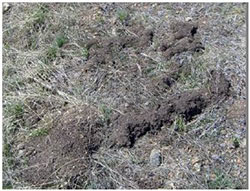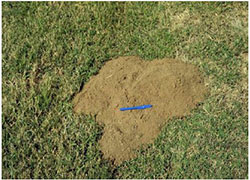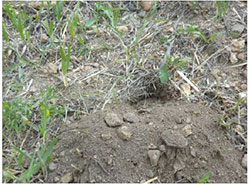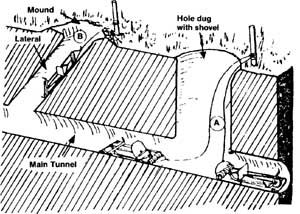by W.F. Andelt and R.M. Case*(2/16)
Quick Facts…
- Four species of pocket gophers are found in Colorado.
- Pocket gophers reduce productivity of portions of alfalfa fields and native grasslands by 20 to 50 percent.
- Damage by pocket gophers can be reduced by exclusion, cultural methods and habitat modification, trapping, and toxicants applied by hand or with a burrow builder.
The four pocket gopher species found in Colorado are distributed almost entirely in different areas (Figure 1), possibly because of different ecological requirements or competition. Plains pocket gophers (Geomys bursarius) are abundant in sandy and silty soils of the plains but are not abundant in compacted soils. The northern pocket gopher (Thomomys talpoides) occurs in upland areas of the eastern plains to shallow gravel in mountainous areas to thin soils of the alpine tundra. It is the most common species in mountain rangelands and aspen forests. Botta’s (formerly called valley) pocket gopher (Thomomys bottae) is found primarily in welldeveloped soils of warm valleys in southern Colorado. The yellow-faced pocket gopher (Pappogeomys castanops) inhabits a portion of southeastern Colorado where the plains pocket gopher is found. However, the yellow-faced pocket gopher is confined to drier sites. Pocket gophers attain the highest densities on light-textured soils with good herbage production. Shallow soils limit pocket gophers due to tunnel cave-ins and poor insulation from warm summer and cold winter temperatures.
Distinguishing among the four pocket gopher species in Colorado is moderately easy. The northern and Botta’s pocket gophers have smooth upper incisors with a single indistinct groove near the inner border and have smaller bodies and proportionately smaller front feet than the plains and yellow-faced pocket gophers. The northern pocket gopher usually is dark-colored with a whitish chin and belly whereas the Botta’s pocket gopher is often reddish-brown with a blackish chin and reddish belly. The plains and yellow-faced pocket gopher species are often difficult to tell apart. The plains pocket gopher has two distinct grooves on the front surface of each upper incisor where as the yellowfaced pocket gopher has one distinct groove.

Figure 1: Distribution map of Botta’s (Thomomys bottae) and Plains (Geomys bursarius) pocket gophers.1 |

Figure 2: Distribution map of Northern (Thomomys talpoides) and Yellow-faced (Pappogeomys castanops) pocket gophers.1 |
Biology, Reproduction and Behavior
Pocket gophers feed on roots they encounter from digging, from vegetation they pull into the tunnel from above, and vegetation above ground near the tunnel. They like above-ground vegetation when it is green and succulent. Many trees and shrubs are clipped just above ground, especially under snow cover.
Pocket gophers construct burrow systems by loosening the soil with their claws and incisors, and then use their forefeet and chest to push the soil out of the burrow. They do not use cheek pouches to carry soil. The soil is deposited in fan-shaped mounds 12 to 18 inches wide and 4 to 6 inches high.
Burrow systems consist of a main tunnel, generally 4 to 18 inches below the soil surface, and a variable number of lateral burrows extending from the main. Lateral burrows end with a soil mound or soil plug at the surface. Burrows are about 2 to 3 1/2 inches in diameter, depending on the size of the gopher. A burrow system may be linear to highly branched, may contain up to 200 yards of tunnels, and may have a hundred or more mounds.
 |
Figure 3: Pocket gopher mound and its relation to the tunnel system. |
The soil from burrow building forms eskers, long snake-like mounds of soil looking like above-ground soil-filled tubes.. Eskers are named due to their similar appearance to the ridges deposited by glacial melt water streams.
Pocket gopher mounds are built of excavated soil. The gophers usually construct one to three mounds per day although the rate varies. One gopher brings about 2 1/4 tons of soil to the surface each year. Mound-building activity usually is greatest in spring and fall.
Pocket gophers usually breed in the spring and produce one litter of one to 10 young (typically three to four) after a gestation period of about 20 days. Usually, only one adult is found in each burrow system except during breeding and while raising young. Six to eight plains pocket gophers per acre are considered high densities whereas northern pocket gophers occasionally reach densities of 20 per acre. Young pocket gophers usually begin dispersing from the natal burrow in June when about one-third grown.
Damage and Control
Pocket gophers can reduce the productivity of alfalfa fields and native grasslands on which they are found by 20 to 50 percent. If gophers are present on 10 percent of a field, they may reduce overall forage productivity of the field by 2 to 5 percent. Gopher mounds dull and plug sickle bars when harvesting hay or alfalfa. Gophers sometimes damage trees by girdling or clipping stems and by pruning roots. Gophers may, at times, destroy underground utility cables and irrigation pipes.
Gophers are not protected by state or federal laws but they do play an important role in ecosystem function. When selecting a damage-control program, consider nonlethal measures such as habitat modification, resistant crop varieties, crop rotation, flood irrigation, or cultivated buffer strips which may be as cost effective as lethal measures and should minimize adverse environmental impacts.

Figure 4: |

Figure 5: |
Figures 4 and 5: Two examples of eskers–these are only seen as the snow melts, and are a result of burrowing activity under the snow. |
|

Figure 6: Mound produced by a pocket gopher. |

Figure 7: Fan-shaped mound with closed burrow is typical of pocket gophers. |
Ecological Value
Pocket gophers are beneficial in several ways. Their burrowing activities increase soil fertility by adding organic matter in the form of plant materials and feces. Burrows increase soil aeration, water infiltration, reduce compaction, mixing organic material into subsurface soil layers and increase the rate of soil formation by bringing up subsoil, subjecting it to weatherization.
Pocket gophers are prey for owls, hawks, badgers, coyotes, foxes, bobcats, skunks, weasels, bullsnakes and rattlesnakes.
Exclusion
Pocket gophers can be excluded from valuable plots of ornamental trees and shrubs with a 1/4 to 1/2-inch mesh hardware cloth fence buried at least 18 inches. The bottom of the fence should be bent at a 90-degree angle so that a 6-inch apron of wire projects horizontally toward the gopher. Place the fence in shallow soil at least 2 feet from the nearest plants to avoid root injury. This method is of limited practicality because of expense and labor. Cylindrical plastic Vexar mesh tubes placed over the entire seedling, including bare root, can reduce damage to newly planted seedlings.
Ornamental beds and vegetable beds can be protected by lining the beds with 1/4″ hardware cloth. The easiest way to do this is to create a raised bed and staple the hardware cloth to the bottom. However, in-ground beds can be dug out to a depth that will accommodate the roots of the plants you wish to grow, lined with hardware cloth, and then refilled with the soil. It is recommended to put a fence at least one foot high, around the beds, to keep the gophers from going over the barrier.
Crop Management
Alfalfa varieties with several large roots rather than a single tap root suffer less when pocket gophers feed on them and are also more resistant to grazing by grasshoppers. Each cut section of roots from a multi-rooted variety will send up a new shoot that may compensate for losses due to gophers.
Rotating alfalfa with grain crops effectively controls pocket gophers because annual grains do not produce large enough roots to support gophers year round. Planting 50-foot wide buffer strips of grain around a hay field can provide unsuitable habitat and minimize immigration of pocket gophers.
Controlling broad-leaf forbs with appropriate herbicide treatments can effectively control northern and Botta’s pocket gophers because they prefer the underground storage structures of the forbs. This method is less effective for plains pocket gophers because they easily survive on grasses. In orchards and shelterbelts, forb control will likely limit gopher damage.
Flood irrigation can effectively control gophers, especially in fields that are leveled to remove high spots that might serve as refuges. The wet-flooded soil generally prevents diffusion of gasses in and out of the burrow and sticks to the pocket gopher’s fur and claws creating an inhospitable environment.
 |
Figure 8: Trap placement in burrow systems: (A) Place two traps set in opposite directions in main tunnel; (B) set single trap in lateral tunnel from which soil plug has been removed. Wire each trap to a stake. |
Trapping
Lethal trapping is one of the best methods to reduce pocket gopher numbers on small to moderate-sized fields (less than 50 acres) and to remove remaining animals after a poison control program. Body-gripping traps (Death Clutch 1, Macabee, Victor, Guardian Gopher Trap), available from hardware and trapping supply stores, work exceptionally well for capturing gophers. Traps can be set in the main tunnel or in a lateral, preferably near the freshest mounds. The lateral tunnel usually can be located by a circular plug (sometimes a depression) in the fan-shaped mound (Figures 3 and 8). Probe into the depression, usually in the direction away from the mound, until the direction of the tunnel is determined. Remove the several-inch plug of soil with a garden trowel or a spade. Insert a trap, secured to a wire and marker stake, with the body gripping jaws about 6 to 8 inches into the tunnel (Figure 8).
Traps also can be set in the main tunnel located about 12 to 18 inches from the mound. After uncovering the main tunnel with a shovel, set two traps as shown in Figure 8. The tunnels either can be left open or covered after setting traps. Check traps twice daily because gophers often visit the traps within a few hours. If a trap is not visited within 48 hours, move it to a new location. Trapping usually is most successful in the spring and fall when gophers are actively building tunnels.
Rodenticides
Using and handling rodenticides safely
When dealing with any rodent problem, utilize all management techniques to resolve the problem and do not rely solely on rodenticides. Set realistic goals such as minimizing the rodent number on your property by using exclusion methods, eliminating desirable habitat or food sources. You’ll never eliminate all pocket gophers. When using any rodenticide always read and follow the label and guidelines and be sure you understand them prior to use to minimize off target (i.e. raptors, dogs, and cats) poisoning. Rodenticides are meant to kill rodents but will also kill other animals if improperly used.
Steps for safe use of rodenticides*
- Positively identify the pest and determine all techniques that can be used to deter the pest such as habitat modification and exclusion.
- Choose the most effective, least toxic rodenticide to minimize potential non-target poisoning.
If you choose to use a rodenticide:
- Read and follow the label.
- Abide by any limitation of use (for example: use only between Nov. 1 and March 30) and other label restrictions.
- Wear proper protective clothing and equipment.
- Don’t smoke or eat while mixing or applying a rodenticide, and wash thoroughly after application.
- Mix and apply only the quantity you need.
*Reference: EPA Citizen’s Guide to Pesticide Safety http://www.epa.gov/safepestcontrol/citizens-guide-pest-control-and-pesticide-safety - Always store rodenticides away from pets, children and wildlife.
- Always locate rodenticides so that off-target species cannot access them (for example: children, pets, wildlife).
- Never store rodenticides near food items for human, pet or livestock.
- Follow the label instructions on carcass surveillance.
Toxicants
Four rodenticides are registered for pocket gopher control in Colorado:
- strychnine (0.25 to 0.5 percent active ingredient),
- zinc phosphide (2 percent active ingredient),
- chlorophacinone (Rozol™) (0.005 percent active ingredient), and
- diphacinone (Eaton’s Answer™)(0.005 percent active ingredient).
Before using any rodenticide, read and follow the label to minimize harm to children, pets, and off-target wildlife.
Strychnine, formulated on milo, barley or wheat, is a widely used toxicant but is highly toxic and potentially hazardous to all wildlife. It usually is labeled as a Restricted-Use Pesticide. Underground baiting with strychnine presents minimal hazards to non-target wildlife but any grain spilled on the surface may be hazardous to ground-feeding birds.
OtherShooting pocket gophers is impractical because they seldom wander above ground. Protect buried utility cables and irrigation lines by enclosing with lead, PVC, or other conduit materials exceeding 2.9 inches in diameter. Pocket gophers can damage cables armored with soft metals (lead, aluminum) if the diameters are less than 2.9 inches. Crushed rock or gravel greater than 1 inch in diameter placed around cables may protect them. |
In some studies, zinc phosphide has been less effective than strychnine. Diphacinone (Eaton’s Answer™) is blended with a water resistant material and is formulated in bait blocks. The blocks provide long-term control because the bait remains effective after killing resident gophers so that invading gophers also are eliminated. Because chlorophacinone (Rozol™) is a multiple dose anticoagulant, more bait is required to achieve adequate control. To poison pocket gophers, place the bait in their tunnel systems by hand or with a burrow builder machine.
Place bait into a burrow system by hand after opening the main tunnel or with a hand probe. Read and follow the product label for bait application technique, timing, personal protective equipment and other precautions. Treat two or three of the freshest mounds within each burrow system (a circle with about a 100-foot diameter). To place bait in the burrow system by hand, locate the main tunnel by digging with a shovel 12 to 18 inches from the plug side of the mound. Place the recommended amount of bait, following label directions, in each direction of the opened main tunnel and well into the system. Close off each tunnel with sod clumps and soil so gophers do not attempt to close the system and cover the bait with soil.
 |
Figure 9: Gopher bait application. (A) Hand application: remove plug in tunnel, starting from gopher mound. Place quantity of bait into main tunnel with a long-handled spoon. Seal tunnel with sod, do not cover bait with soil. (B) Probe application: Locate main tunnel with probe as described in text. With spoon, drop bait into tunnel through hole made by probe. Cover probe hole with sod. Bait-dispensing probe: Locate main tunnel with probe, push lever or plunger to dispense bait into tunnel, cover probe hole with sod. |
A less time-consuming baiting method involves using a pointed-rod hand probe. Locate the main tunnel 12 to 18 inches from the plug side of the mound by pressing the probe into the ground (Figure 8). Determine the location of the tunnel by the decreased friction on the probe. Place bait through the probe hole into the tunnel. A reservoir-type bait probe dispenser also is available for poisoning gophers (Figure 9). A button is pushed on the bait probe when it is pushed in the burrow and a metered dose of bait drops into the burrow. Place the recommended amount of bait down each of two or three probe openings and then cover the probe holes with sod.
The burrow builder (The Verminator™) mechanically delivers bait underground so large acreages can be treated economically for pocket gopher control. Burrow builders are available in a standard hydraulically operated unit or a three-point hitch model. The device consists of a knife and torpedo assembly that makes an artificial burrow at desired soil depths, a coulter blade that cuts roots of plants ahead of the knife, a seeder assembly for bait dispensing, and packer wheel assembly to close the furrow behind the knife. The seeder box has a metering device for dispensing various poison baits at desired rates. Burrow builders can be used successfully in agricultural mountainous areas if the soil is not extremely rocky. However, operations on steep slopes can result in poorly constructed tunnels or damage to the torpedo.
To achieve good results with a burrow builder:
- Adjust the burrow builder to construct tunnels at the same depth as those constructed by gophers in your area so that gophers intercept the tunnels.
- Use the machine only when the soil moisture is adequate. If the soil is too dry the burrow may collapse and if the soil is too wet the slot over the tunnel may not close (generally, the soil moisture is adequate if a compressed handful holds its shape).
- Space the burrows at 20- to 30-foot intervals in areas of infestation (burrow spacing is dependent on gopher densities and species involved; usual spacing for the northern and Botta’s pocket gophers is 20 to 25 feet and 25 to 30 feet for the plains and yellow-faced pocket gophers).
- Periodically check to assure formation of a good burrow and check if bait is dispensing down the tube.
- Enclose the perimeter of the field with artificial burrows to prevent reinvasion.
- Follow directions provided with the burrow builder machine.
Recommended application rates of 1 to 2 pounds per acre of 0.35 to 0.5 percent strychnine provide 85 to 95 percent control. Clean up any spilled bait and properly dispose. Bury any dead gophers found above ground to reduce hazards to predators and scavengers. Harrowing the field about one week after treatment to level mounds and then retreating by hand or trapping at new mounds should result in more complete control.
Fumigants, such as aluminum phosphide and gas cartridges, are not very successful for controlling pocket gophers because gophers either sense the poisonous gas and plug the tunnel or the fumigants diffuse into the soil, particularly when it is dry. Pocket gophers reportedly can be controlled by injecting exhaust from an old vehicle without antipollution devices into the burrow for about 3 minutes.
1Distribution Maps: Redrawn based on Armstrong, David M., Fitzgerald, James P., and Meaney, Carron A., 2011. Mammals of Colorado 2nd ed.: Denver Museum of Nature & Science and University Press of Colorado.
*W.F. Andelt, Colorado State University Cooperative Extension wildlife specialist and associate professor, fishery and wildlife biology; and R.M. Case, forestry, fisheries and wildlife, University of Nebraska. S. Bokan, Small Acreage Coordinator, Boulder County, K. Crumbaker, Ag and Natural Resources Agent, Larimer County, T. Hoesli, Grand County Extension County Director, D. Lester, Park County Extension County Director, & I. Shonle, Gilpin County Extension Director. 11/95. Revised 2/16.
Go to top of this page.





